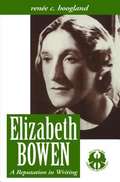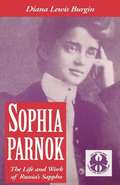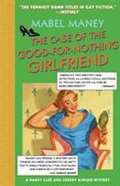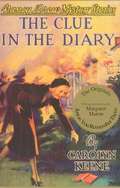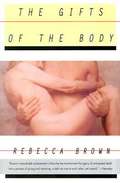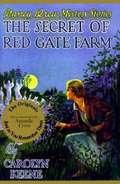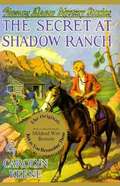- Table View
- List View
Medical, Psychosocial, and Vocational Aspects of Disability (First Edition)
by Martin G. BrodwinA textbook intended for professionals who assist disabled people
Not a Passing Phase: Reclaiming Lesbians in History, 1840-1985
by Lesbian History GroupA collection of essays and articles about "romantic friendships" between famous women of the past.
Passions Between Women: British Lesbian Culture 1668-1801
by Emma DonoghueA groundbreaking work of lesbian scholarship, Passions Between Women discovers and brings together for the first time stories of lesbian desires, acts, and identities from the Restoration to the beginning of the nineteenth century. Where previous historians have concluded that a combination of censorship and ignorance excluded lesbian experience from written history before our era, Emma Donoghue has decisively proved otherwise. She dispels the myth that seventeenth- and eighteenth-century lesbian culture was rarely registered in language and that lesbians of this period had no words with which to describe themselves. Far from being invisible, the figure of the woman who felt passion for women was a subject of confusion and contradiction: she could be put in a freak show as a "hermaphrodite," revered as a "romantic friend," or jailed as a "female husband." By examining a wealth of new medical, legal, and erotic source material, and rereading the classics of English literature, Emma Donoghue has uncovered narratives of an astonishing range of lesbian and bisexual identities in Britain between 1668 and 1801. Female pirates and spiritual mentors, chambermaids and queens, poets and prostitutes, country idylls and whipping clubs all take their place in her intriguing panorama of lesbian lives and revisionist and frankly sexual in its outlook, Passions Between Women boldly asserts that relationships between women were, more passionate than the "romantic friendships" oked by other scholarly works.
Political Poison
by Mark Richard ZubroSecond Paul Turner mystery; gay detective with two children; sequel to Sorry Now.
The Winecoff Fire: The True Story of America's Deadliest Hotel Fire
by Allen Goodwin Sam HeysAlmost a half-century later, the question still persists: accident or arson? As America slept in the predawn hours of December 7, 1946—in preparation for a somber remembrance of the fifth anniversary of Pearl Harbor Day—280 of its citizens awoke suddenly in a hotel already burning wildly out of control. For the next two and a half hours, they would fight their own war, mostly against their own surging, unrelenting fear. Like the “unsinkable” Titanic, Atlanta’s Winecoff Hotel had been billed as "fireproof.” And, in fact, it was. The hotel did not burn. Its guests did. Or they died on the sidewalk of Peachtree Street, or in quiet clusters, huddled together for courage against the silent, suffocating smoke. It was the worst hotel fire ever, anywhere. The fact that today it is still the worst hotel fire in North America—and second worst in the world—is testament to its horror. One hundred nineteen people died. The rest survived by extraordinary heroism or blind luck. This is their story—all of them, the dead and the lucky—a story of ordinary lives colliding with catastrophe, a moment frozen in time. And a story of an investigation that went awry.
Wolf Girls At Vassar: Lesbian and Gay Experiences 1930-1990
by Anne MaccayA collection of reflections by lesbian and gay Vassar graduates recalls the struggles of homosexuals living under a cloud of silence and repression for the past sixty years. Reprint.
Women On Women 2: An Anthology of American Lesbian Short Fiction
by Joan Nestle Naomi HolochSecond in this series of anthologies.
Am I Blue? Coming Out from the Silence
by Marion Dane BauerShort stories dealing with gay and lesbian teens etc.
Elizabeth Bowen: A Reputation in Writing
by Renee C. HooglandImmensely popular during her lifetime, the Anglo-Irish writer Elizabeth Bowen (1899-1973) has since been treated as a peripheral figure on the literary map. If only in view of her prolific output--ten novels, nearly eighty short stories, and a substantial body of non- fiction--Bowen is a noteworthy novelist. The radical quality of her work, however, renders her an exceptional one. Surfacing in both subject matter and style, her fictions harbor a subversive potential which has hitherto gone unnoticed. Using a wide range of critical theories-from semiotics to psychoanalysis, from narratology to deconstruction-this book presents a radical re-reading of a selection of Bowen's novels from a lesbian feminist perspective. Taking into account both cultural contexts and the author's non-fictional writings, the book's main focus is on configurations of gender and sexuality. Bowen's fiction constitutes an exploration of the unstable and destabilizing effects of sexuality in the interdependent processes of subjectivity and what she herself referred to as so-called reality.
Fat Girl Dances With Rocks
by Susan StinsonIt's the summer of drinking and driving, disco and diets, fake IDs and geology, and fat 17-year-old Char is wondering if she is animal, vegetable, or mineral. What does it mean when your best friend French-braids your hair, kisses you on the lips, and leaves town? Char gets a summer job in a nursing home, and meets people with bodies and abilities as various as the textures of the rocks her friend Felice collects. Fat Girl Dances with Rocks is a novel about the many shapes of beauty: the fold of a belly, the green swelling of seedlings, the sharp edges of granite, obsidian, and flint. Fat Girl Dances with Rocks is a coming of age story. It is a coming out story, and for Char, it is a story of coming into her own body - all the way to the edges of her skin.
Painted Moon
by Karin Kallmaker"...a delicious romance with just a hint of intrigue...an uncommonly realistic romance, one that surmounts class, race, and closets". -- Small Press Magazine
Sophia Parnok: The Life and Work of Russia's Sappho
by Diana L. Burgin"The weather in Moscow is good, there's no cholera, there's also no lesbian love... Brrr! Remembering those persons of whom you write me makes me nauseous as if I'd eaten a rotten sardine. Moscow doesn't have them--and that's marvellous." Anton Chekhov, writing to his publisher in 1895. Chekhov's barbed comment suggests the climate in which Sophia Parnok was writing, and is an added testament to to the strength and confidence with which she pursued both her personal and artistic life. Author of five volumes of poetry, and lover of Marina Tsvetaeva, Sophia Parnok was the only openly lesbian voice in Russian poetry during the Silver Age of Russian letters. Despite her unique contribution to modern Russian lyricism however, Parnok's life and work have essentially been forgotten. Parnok was not a political activist, and she had no engagement with the feminism vogueish in young Russian intellectual circles. From a young age, however, she deplored all forms of male posturing and condescension and felt alienated from what she called patriarchal virtues. Parnok's approach to her sexuality was equally forthright. Accepting lesbianism as her natural disposition, Parnok acknowledged her relationships with women, both sexual and non-sexual, to be the centre of her creative existence. Diana Burgin's extensively researched life of Parnok is deliberately woven around the poet's own account, visible in her writings. The book is divided into seven chapters, which reflect seven natural divisions in Parnok's life. This lends Burgin's work a particular poetic resonance, owing to its structural affinity with one of Parnok's last and greatest poetic achievements, the cycle of love lyrics Ursa Major. Dedicated to her last lover, Parnok refers to this cycle as a seven-star of verses, after the seven stars that make up the constellation. Parnok's poems, translated here for the first time in English, added to a wealth of biographical material, make this book a fascinating and lyrical account of an important Russian poet. Burgin's work is essential reading for students of Russian literature, lesbian history and women's studies.
Taking Charge: The Electric Automobile In America
by Michael Brian SchifferA history of electric cars.
The Case Of The Good-For-Nothing Girlfriend
by Mabel ManeySecond in the Nancy Clue and the Hardly Boys series; parody.
The Clue in the Diary (Nancy Drew Mystery Stories #7)
by Carolyn KeeneWhen a local shyster's home burns to the ground, was he in it? Follow Nancy, aided by George, Bess, and handsome Ned Nickerson as they delve into a man swindling local inventors, a fire that demolishes his home and a few clues left near the scene to determine the cause of the fire and who was responsible. This facsimiled edition of the original volumes and story lines is not to be confused with later condensed, updated versions.
The Gifts of the Body
by Rebecca BrownA woman volunteer who cares for people with AIDS narrates a poignant account of the clients she comes to love in her role as a home-care aide, in a bittersweet novel about life, illness, death, and remembrance. By the author of The Children's Crusade.
The Mystery at Lilac Inn (Nancy Drew Mystery Stories #4)
by Carolyn KeeneNancy wants desperately to help a friend recover her inheritance when she comes of age. Twists and turns and too many clues and too many suspects leave Nancy feeling she may never solve this riddle. So, she takes a risk, only to find herself in a pickle! How will she ever get away to find the inheritance and restore it to its rightful owner? Beginning in the late 1950s, the first 34 Nancy Drew books were revised and shortened. This is the original version of this title.
The Secret of Red Gate Farm (Nancy Drew Mystery Stories #6)
by Carolyn KeeneWhat do a chance purchase of exotic perfume, a sickly girl job-hunting, and a struggling farm have in common? Nancy, accompanied by George and Bess visit Millie and her Grandma at Red Gate Farm and become suspicious of a secret society. Amidst learning about farm life, they daringly investigate, but what will they find? <p><p> This facsimiled edition of the original volumes and story lines is not to be confused with later condensed, updated versions.
The Secret of Shadow Ranch (Nancy Drew Mystery Stories #5, Original Version)
by Carolyn KeeneNancy and her buddies travel to Arizona to help evaluate a run-down ranch and possibly help ready it for sale. Once in Arizona, Nancy uncovers a strange mystery about a kidnapped child. Follow their mishaps, multiple rides they get lost on, and an odd cast of characters leading to a most unlikely reunion. This is a facsimiled edition of the original volume; story line is not to be confused with later condensed, updated versions.
A Ghost in the Closet: A Hardly Boys Mystery
by Mabel ManeyThird in the Nancy Clue and the Hardly Boys series; parody.
Aimee & Jaguar: A Love Story, Berlin 1943
by Edna Mccown Erica FischerA real-life love story between two women, one of them a Jew living illegally on the streets during WWII.



